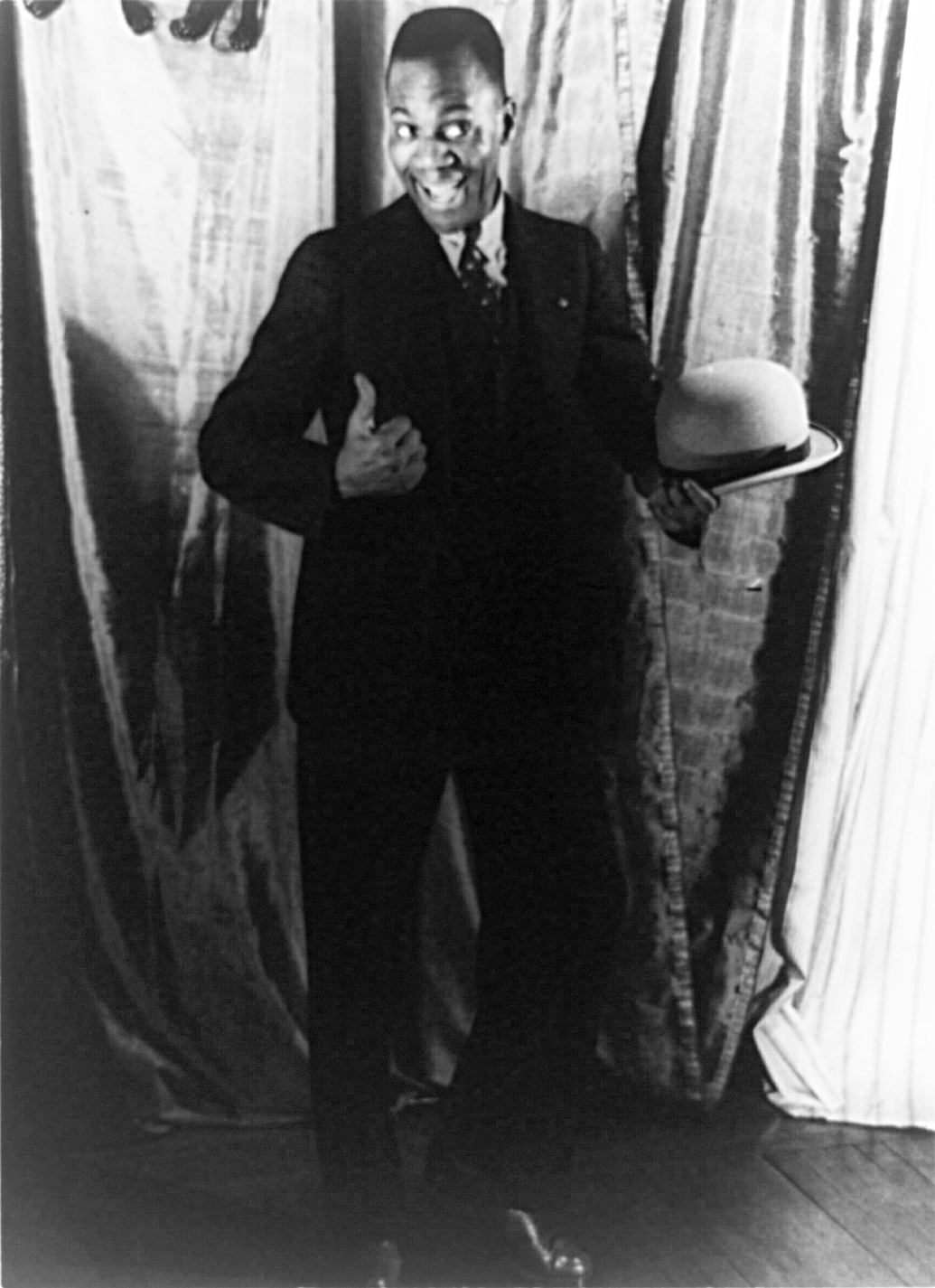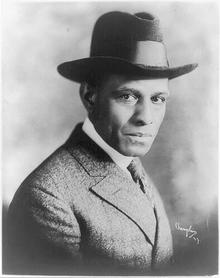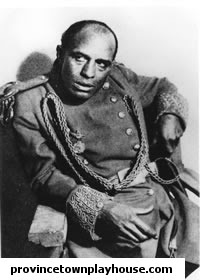If you've read the 'About Me' section of this blog, you'll know that I'm born and raised in Virginia--Richmond, Virginia to be more specific--"Cap City", Capital of what used to be known as "The Confederacy". We've got a memorial to Jefferson Davis, statues of Generals Robert E. Lee and "Stonewall" Jackson, and also a memorial dedicated to the late tennis great, Mr. Arthur Ashe.
 |
| Arthur Ashe Memorial |
Richmond, Virginia was also home to two legendary pioneers of entertainment: Bill "Bojangles" Robinson and Charles Sidney Gilpin.
 |
| Bill "Bojangles" Robinson |
"Bojangles" was born Luther Robinson on May 25, 1878 in Richmond, Virginia. In 1885, both of his parents died--his father from chronic heart disease and his mother from natural causes--leaving Luther and his younger brother, William to be raised by their grandmother, Bedilia, a formerly enslaved woman. Ms. Bedilia was ill and unable to raise the boys (and according to some sources, she wasn't interested in raising them either).
How did Luther Robinson become Bill Robinson?
Luther Robinson actually hated his birth name and legend has it that he bullied his little brother, William, into giving him his name--thus, at a very young age, Luther Robinson became Bill Robinson (and William changed his name to Percy). Bill Robinson began dancing--"hoofing" rather--at local beer gardens and he soon dropped out of school to make a career out of his hobby. By the time he'd reached his mid-late teens, Bill Robinson had become a hard-working vaudevillian.
************
Even through serving in two wars (first as a drummer boy in the short Spanish-American War of 1898, later as a rifleman during World War I), Bill Robinson's career gradually blossomed throughout the early half of the 20th century. He'd gone from being a vaudeville favorite to a Broadway favorite--and later would become a beloved on-screen performer.
Watch Mr. Robinson do his famous "Stair Dance" below:
Bill "Bojangles" Robinson died on November 25, 1949 of heart failure. He was 71 years old.
His funeral was arranged and paid for by his friend, Ed Sullivan (Mr. Robinson had fallen on hard times in the later years of his life) and held at the 369th Infantry Regiment Armory near Harlem (the Infantry he served with during WWI). About 32,000 people attended the services and the eulogy--given by Adam Clayton Powell, Sr.--was broadcast over the radio.
************
 |
| Charles S. Gilpin |
Charles Sidney Gilpin was born on November 20, 1878 in Richmond, Virginia. Before finding a career in theatre, young Charles had found work as an apprentice for in the Richmond Planet print shop. At the age of 18, he left Richmond to join pursue a long-lasting stage career. However, like other performers, he had to work odd jobs for financial stability. While establishing a career as an actor, he also worked as a barber, a printer, a boxing trainer, an elevator operator, and a railroad porter. He also sang in a few choruses.
Charles Gilpin began taking on dramatic roles in 1907 when he performed with Robert Mott's Pekin Theater in Chicago. Then, he left Robert Mott's Theater in 1911 to tour the US with the Pan-American Octetts. In 1915, he joined the Anita Bush Players (later known as The Lafayette Players--a stock company that would help to launch the careers of many black actors, including Gilpin). A salary dispute would cause Mr. Gilpin to leave Bush's company, but his reputation with them would garner him roles on Broadway. First (in 1919), he was hired to play the role of Rev. William Curtis in John Drinkwater's play, Abraham Lincoln and soon after, he was cast in his defining role--the lead in Eugene O'Neill's The Emperor Jones.
The 1920 role of Brutus Jones made Charles Gilpin a Broadway star. It also made him the first African-American to be named by the Drama League of New York as one of ten people who'd done the most for American theater that year. In 1921, he was awarded the NAACP's Spingarn Medal and was also honored at the White House by President Warren G. Harding. In 1922, the Dumas Dramatic Club (now known as the Kamaru Players) of Cleveland renamed itself the Gilpin Players.
Unfortunately, when The Emperor Jones closed on Broadway after 204 performances, Charles and Eugene O'Neill began having a dispute over the constant use of the word "ni**er" in the play. Gilpin insisted that O'Neill change the word and O'Neill refused. When The Emperor Jones was revived in 1924, Charles Gilpin was replaced by up-and-coming entertainer Paul Robeson.
The disappointment of losing his landmark role drove Mr. Gilpin to drink. Although he worked in two films in 1926 and 1927, he never worked on the Broadway stage again. His health declined rapidly and he passed away on May 6, 1930 in Eldridge Park, New Jersey. He was 51 years old.
The Scar of Shame (1927) featuring Charles Sidney Gilpin is currently available on Youtube.
***********
The Richmond Natives Honored:
In 1933, while visiting his hometown of Richmond, Virginia, Bill Robinson spotted two children who were having a hard time crossing the street to retrieve a ball. Witnessing this made Mr. Robinson pay to have a stoplight installed at the intersection. A statue dedicated to Mr. Bill "Bojangles" Robinson was sculpted in aluminum by Jack Witt and erected by the Astoria Beneficial Club at this same intersection (on the corner of Leigh and West Adams streets) in 1973. You can ride down this street today and see "Mr. Bojangles" smiling at you.
Gilpin Court, the public housing projects in Richmond's Jackson Ward neighborhood were completed in 1943. My own paternal family is deeply rooted in the great Jackson Ward area, as well as in and near the public housing apartments named after Charles Sidney Gilpin. There's been a lot of talk about redevelopment over the years--as it usually is for areas like this.
I hate to get political all of a sudden, but if you ask me, not only do the people of the once-thriving area deserve better, but the legacy of Charles Gilpin deserves way better as well. That's all I will say.
************
All of those interested in American History, Black American History, Entertainment History, Black Entertainment History, etc.--come visit my hometown of Richmond, Virginia. Go ride through the Historic Jackson Ward area (you should visit during the annual 2nd Street Festival) to see where legends were born and where legends grew up.
************
SOURCES
Bill "Bojangles" Robinson
Charles Sidney Gilpin
Special thanks to one of my high school teachers, a commentator and follower of this blog who gave me the inspiration and idea for this post! Thanks for following, Mr. Smith!
************
I do not own any of the photos in this post. In order to credit the sources in which I obtained the above photos, I added custom watermarks with their URLs. Photos without watermarks were obtained from Wikipedia. If the rightful owner(s) of any of these images wants them removed, please contact me and I will do so as soon as possible.--Adrienne
.jpg)


Adrienne,
ReplyDeleteWhat a great post!!! I am glad I could help.